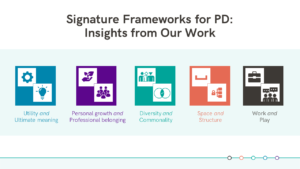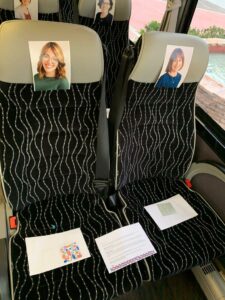Walking the Tightrope of Work and Play: Insights on Designing Professional Development Experiences
May 25th, 2021
When’s the last time you played, not simply to recover from your work, but to enhance your work? When we think of work and play, we often see them as two distinctive and opposite sides of a spectrum. How can we bring work and play closer together and why is it important to do this in the context of training educators?
This was one of the questions that ten Jewish organizations, including M2: The Institute for Experiential Jewish Education, explored during a three-year community of practice called the Professional Development Initiative (PDI). Facilitated by Rosov Consulting with support from the Jim Joseph Foundation, the PDI uncovered core principles for design that led to powerful professional development for Jewish educators across diverse initiatives and audiences.
In the culminating report that tracked ten professional development initiatives, five dichotomies emerged that are worth considering when designing any cohort learning experience: aiming to provide utility and ultimate meaning, focusing on personal growth and professional belonging, fostering diversity and commonality, offering space and structure, and emphasizing work and play. All ten aims are desirable, but many are in opposition with another. The imagery that comes to mind is a seesaw – each side of the spectrum is polarized, and favoring one is at the direct expense of the other.

Of the ten considerations, that last word – “play” – stuck out the most for me. Play can be an unstructured period of down time that offers relief from an intense experience. It can also be more structured, aiming to enrich social opportunities in order to foster a solid group dynamic. Alternatively, it can supplement the central focus of a program in the form of recreation, such as morning yoga or a game night. If work has gone on too long or has become too intense, or if foundations need to be laid for work that is yet to come, the seesaw imagery comes back to mind. Prioritize play now, so we can prioritize work in the future.
M2 stands for Malechet Machshevet – a deliberate craft. We try to live up to our name in how we craft educational experiences, and one of our guiding principles is to make the work engaging. To best explore values, ideas, and content, we immerse leaders in experiences that offer space for them to actively play with those values, ideas, and content, as opposed to merely thinking about them. In other words, we aim to move out of the abstract and into the concrete.
 For example, in one seminar that explored the value of partnership, 40 seasoned educators unconventionally began their morning by boarding a “Partner-Ship” bus. At their assigned seat, each participant found a discussion prompt to help them get to know their partner. They arrived at the beach and competed to build sand castles and moats in pairs, experiencing firsthand how they work with someone else. The day continued with chavruta-style learning, and by early afternoon, each participant had a better understanding of what they offer as a partner – and what they seek in a partner. And all of this was done through a playful, dynamic, energizing, and challenging experience.
For example, in one seminar that explored the value of partnership, 40 seasoned educators unconventionally began their morning by boarding a “Partner-Ship” bus. At their assigned seat, each participant found a discussion prompt to help them get to know their partner. They arrived at the beach and competed to build sand castles and moats in pairs, experiencing firsthand how they work with someone else. The day continued with chavruta-style learning, and by early afternoon, each participant had a better understanding of what they offer as a partner – and what they seek in a partner. And all of this was done through a playful, dynamic, energizing, and challenging experience.
Work and play – not recovery from the work, but play as the work itself – are not on opposite sides of a spectrum, seesawing back and forth but never coming together. A more accurate metaphor is a tightrope, where both forces are present at all times. Each side gets pulled and each offers support in different proportions, depending on where the acrobat stands. Regardless of where that may be, the two sides are in constant consideration of one another, even if one is carrying more weight. In this frame, the work of the educator is a balancing act, always aware of the dichotomies involved and attempting to integrate these forces in relation to each other.
As part of the PDI, a case study was written and analyzed about an M2 seminar called “The Architecture of Immersive Experiences.” In an attempt to draw a parallel between architectural principles in the built world and design principles in the world of educational experiences, learners spent five days in the heart of New York City, where a significant portion of the program was spent touring landmarks around Manhattan, guided by an architect, to see the principles firsthand. This is play at its best.
However, the temptations that play offers mean that we don’t always get the balance right. When we analyzed this case study in a PDI roundtable, questions surfaced about the prominence that play was given. Would a one-day tour of Manhattan have done the trick? Did too much play detract from the work that learners had come to do? Hearing questions and advice from our PDI colleagues offered valuable perspective that was taken to heart: it’s likely that while the approach may have been correct, the work-play balance was off.
roundtable, questions surfaced about the prominence that play was given. Would a one-day tour of Manhattan have done the trick? Did too much play detract from the work that learners had come to do? Hearing questions and advice from our PDI colleagues offered valuable perspective that was taken to heart: it’s likely that while the approach may have been correct, the work-play balance was off.
It is with this valuable insight and feedback that M² is able to continue the work – playfully of course! – of designing powerful, compelling experiences for and with Jewish educators. We are also able to rediscover, over and over again, that they do not need to be opposites. Instead, work and play – and all other design principles for powerful professional development – can, and often should, exist in a state of creative tension that makes each polarity more powerful and meaningful.
Kiva Rabinsky is the Chief Program Officer at M²: The Institute for Experiential Jewish Education, and lives in Jerusalem with his wife, Deb, and children, Nava and Yonah. Prior to working at M², he directed a range of Jewish Service Learning initiatives and developed and taught in a series of Experiential Jewish Education training programs through his role at Yeshiva University. Kiva holds an MPA in Nonprofit Management, and an undergraduate degree in Education and Archeology. Kiva can be reached at [email protected].